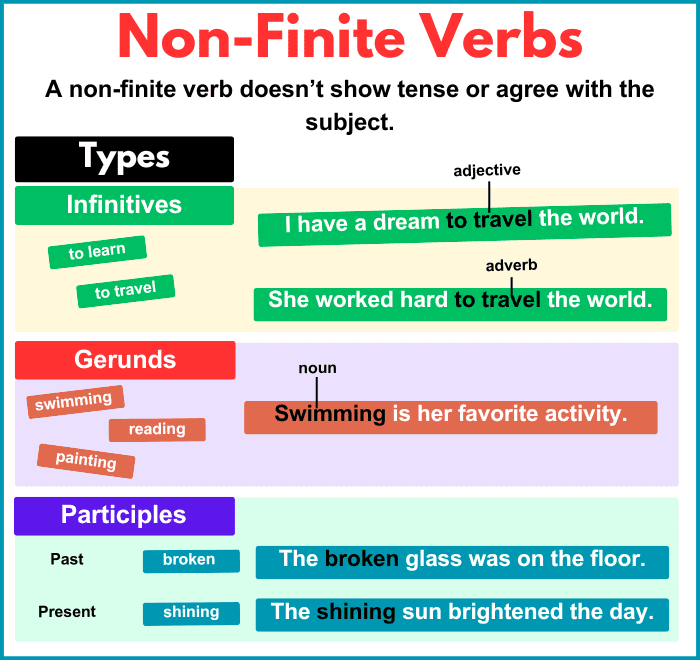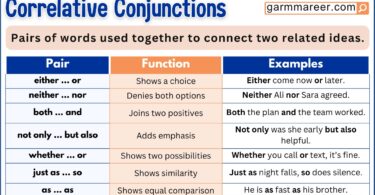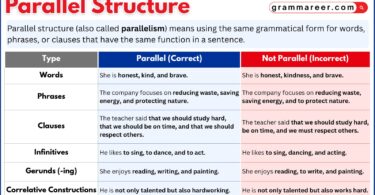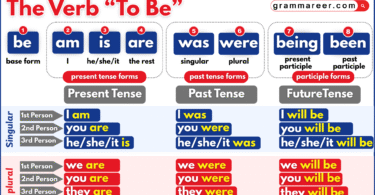In English grammar, non-finite verbs play a crucial role in sentence construction and understanding verb functions. These verbs do not change their form based on the subject, tense, or number. Understanding non-finite verbs is essential for mastering complex sentences and improving fluency.
A non-finite verb is a verb form that does not act as the main verb in a clause and does not show tense.
Table of Contents
How to Use Non-Finite Verb in Sentences?
Non-finite verbs are versatile and appear in different contexts:
As Subjects:
- Swimming is a great workout.
Swimming serves as the subject of the sentence.
As Objects:
- He enjoys reading books.
Reading is the object of the verb enjoys.
In Modifiers or Adjective Phrases:
- The girl running in the park is my sister.
Running modifies the noun girl.
In Purpose Clauses:
- He left early to catch the train.
To catch indicates the purpose of leaving early.
Real-Life Examples of Non-Finite Verb
Here are some Examples that will improve you to understand Non-Finite verb:
- Ali plans to study abroad.
- Fatima loves baking cakes.
- The documents signed by Ahmed were important.
- To read every day improves comprehension.
- The running water caused a flood.
- She avoided meeting new people at the event.
- Ahmed started to learn Spanish.
- The broken glass was swept away.
- Walking in the rain can be refreshing.
- The completed project was submitted on time.
- They decided to postpone the meeting.
- Watching movies is a common hobby.
- The crying baby was comforted by her mother.
- To travel abroad is my dream.
- The laughing crowd filled the hall.
- She enjoys writing letters to her friends.
- The rising sun illuminated the sky.
- Ali hoped to finish the work by evening.
- The burnt toast was thrown away.
- Climbing mountains is an adventurous activity.
Types of Non-Finite Verbs
1. Infinitives
These are base forms of verbs, often preceded by “to.”
Examples:
- Hassan decided to join the meeting.
To join indicates Hassan’s decision.
- She wants to improve her skills.
To improve expresses purpose.
2. Gerunds
These are verbs ending in “-ing” that function as nouns.
Examples:
- Areeba’s favorite activity is painting.
Painting serves as the subject complement.
- Running helps keep you fit.
Running acts as the subject of the sentence.
3. Participles
Participles act as adjectives or form part of verb phrases.
- Present Participle: The crying baby needs attention. Crying describes the baby.
- Past Participle: The broken vase was on the table. Broken describes the vase.
Differences Between Non-Finite and Finite Verb
Here are some key differences of Non-Finite and Finite Verb:
| Feature | Finite Verb | Non-Finite Verb |
|---|---|---|
| Tense | Show tense | Do not show tense |
| Subject Agreement | Agree with the subject | Do not agree with the subject |
| Function | Act as the main verb | Act as modifiers, subjects, or objects |
| Examples | She runs every morning. | Running every morning is healthy. |
| Examples | They ate dinner early. | To eat dinner early is wise. |
Check Your Understanding of Non-Finite Verbs
Identify the non-finite verbs in these sentences:
- To learn new skills is important.
- The laughing children filled the room with joy.
- Ahmed enjoys swimming in the evening.
Answers:
- To learn
- Laughing
- Swimming
FAQs
A non-finite verb doesn’t show tense or agree with the subject.
To run is healthy.
Writes, Play, Is, Saw, Loves, Jumps, Can, Am, Drank, Were.
No, non-finite verbs cannot act as the main verb. They function as parts of phrases, modifiers, or complements but do not carry tense.
A gerund functions as a noun (e.g., Reading is fun), while a participle acts as an adjective (e.g., The reading material was helpful).
An infinitive is the base form of a verb, usually with “to” (e.g., to eat). A non-finite verb includes infinitives, gerunds (e.g., eating), and participles (e.g., eaten), all of which don’t show tense or subject agreement.
Conclusion
Understanding non-finite verbs is essential for crafting more advanced and nuanced sentences. By recognizing their types and uses, learners can improve both written and spoken English. Practice identifying and using non-finite verbs to master this important aspect of grammar.
You May Also Like





